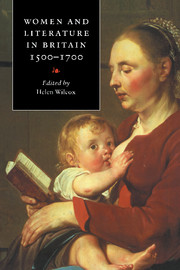Book contents
- Frontmatter
- Contents
- List of contributors
- Acknowledgements
- A note on references
- Chronology: women and literature in Britain, 1500–1700
- Introduction
- Part I CONSTRUCTING WOMEN IN EARLY MODERN BRITAIN
- Part II WRITING WOMEN IN EARLY MODERN BRITAIN
- Chapter 7 Renaissance concepts of the ‘woman writer’
- Chapter 8 Courtly writing by women
- Chapter 9 Women's poetry in early modern Britain
- Chapter 10 Women's writing and the self
- Chapter 11 The possibilities of prose
- Chapter 12 The first female dramatists
- Further reading
- Index
Chapter 7 - Renaissance concepts of the ‘woman writer’
Published online by Cambridge University Press: 22 September 2009
- Frontmatter
- Contents
- List of contributors
- Acknowledgements
- A note on references
- Chronology: women and literature in Britain, 1500–1700
- Introduction
- Part I CONSTRUCTING WOMEN IN EARLY MODERN BRITAIN
- Part II WRITING WOMEN IN EARLY MODERN BRITAIN
- Chapter 7 Renaissance concepts of the ‘woman writer’
- Chapter 8 Courtly writing by women
- Chapter 9 Women's poetry in early modern Britain
- Chapter 10 Women's writing and the self
- Chapter 11 The possibilities of prose
- Chapter 12 The first female dramatists
- Further reading
- Index
Summary
S/he who writes, writes. In uncertainty, in necessity. And does not ask whether s/he is given the permission to do so or not. Yet, in the context of today's market-dependent societies, ‘to be a writer’ can no longer mean purely to perform the act of writing. For a laywo/man to enter the priesthood – the sacred world of writers – s/he must fulfill a number of unwritten conditions.
(Trinh T. Minh-ha, Woman, Native, Other: Writing, Postcoloniality, and Feminism)Though her words pertain to twentieth-century writers, Trinh T. Minh-ha provides a useful starting point for this chapter's survey of some theoretical and practical issues that attend, and complicate, the various concepts of the ‘woman writer’ circulating in early modern Britain and in modern scholarship about that period. The name ‘Britain’ in this era signals, we need to remember, a highly contested political and geographical site: England's formal union with Scotland did not occur until 1707, with Ireland only in 1801, and in this era Scottish and Irish territories were being forcibly claimed (along with more distant territories across the Atlantic and the English Channel) by a crown that had annexed Wales only in 1536. In this period of British history many ‘unwritten conditions’ governed writing as a domain of (frequently disputed) cultural meanings and values.
- Type
- Chapter
- Information
- Women and Literature in Britain, 1500–1700 , pp. 143 - 168Publisher: Cambridge University PressPrint publication year: 1996
- 14
- Cited by

